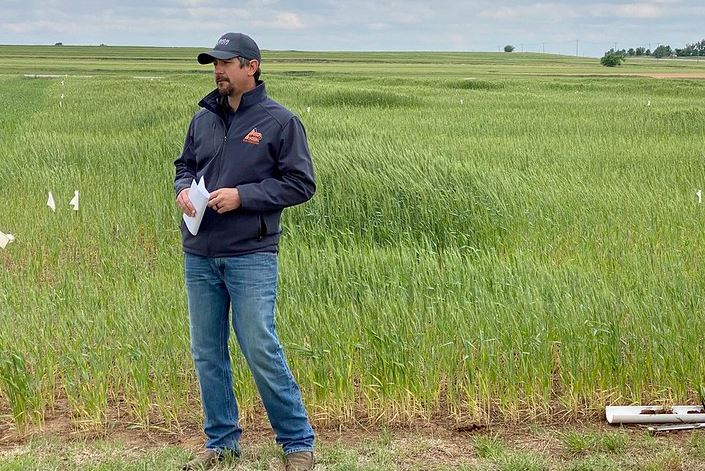
In a season marked by unpredictable weather, Oklahoma producers are navigating a complex landscape of planting delays, concerns about crop vigor, and the potential for double-cropping opportunities. OSU Precision Nutrient Management Extension Specialist Dr. Brian Arnall shared his observations and advice with Farm Director KC Sheperd, highlighting the resilience of some crops while emphasizing strategic planning for others.
Dr. Arnall, speaking from a “sloppy” Payne County Pasture Tour, noted the keen interest among producers in weed identification and management, even in the face of challenges. “They did a weed identification test to see if they could identify ten of the weed species out in the pasture, and we really walked through their impact, management, and control, whether it’s through fertility or herbicide,” he explained.
Mixed Bag for Summer Crops
The corn crop, for the most part, is thriving. “Corn is loving life!” Dr. Arnall exclaimed. “The corn got in at a really good time, for the most part, where it wasn’t flooded out. We’ve got some of the best corn I’ve seen in a long time.” He even lightheartedly mentioned that OSU’s fertility research, which aims to study corn under drought stress, is having difficulty this year due to abundant moisture.
However, the outlook for sorghum and soybeans is more varied. “The cooler, damp weather has been holding back progression,” Dr. Arnall observed. “They’re trying to see how it comes. We just need a couple of good days of heat.” Stand establishment, he noted, has been “hit and miss” due to the wet soils. Cotton is facing similar challenges, with “stand establishment, with these cool, wet soils” being a major question.
Producers are now focusing on nutrient management and disease concerns for these summer crops. “We have to do a wait and see,” Dr. Arnall said. “We need to get the crop up and going, and get some crop vigor to see how it takes off, and make some decisions on that.”
Wheat Woes and Double Crop Opportunities
The wheat harvest is proving to be a significant hurdle. “I’ve already been getting notes about wheat sprout in heads,” Dr. Arnall shared, expressing concern about getting the crop out due to excessive moisture. “If we can get it out – we just need a couple of days of dry – I’ve got wheat from basically Texas to Kansas that is ready to go. It just needs to dry out.”
Despite the struggles, the wet conditions present an unexpected upside for double-cropping. “The positive being, we’re getting some really good soil moisture,” Dr. Arnall noted. “So that double crop, whether it’s corn, soy, or sorghum, there are a lot of people ready to pull that trigger as soon as they can to start dropping seed in for that double crop.”
Double Cropping: Planning is Key
For producers considering double-cropping, Dr. Arnall offered crucial advice, starting with weed control. “A challenge with double crop is if I plant corn, soy, or sorghum early in the season, it gets this canopy and helps shade out a lot of the weeds. Double crop is a shorter season, so it doesn’t get that canopy.” He emphasized the importance of pre-emergent herbicides with residual control to combat flushes of weeds.
On the fertility side, he recommended applying pre-plant fertility or soon after planting for double crops, as July and August typically receive less rainfall. Producers should also assess the nutrient status of their previous wheat crop. “If I’m going with corn or sorghum, I’m probably going to have to look at some nitrogen fertility,” he suggested, especially if inputs weren’t applied to the wheat. For soybeans, ensuring adequate phosphorus, particularly in low-pH soils, is vital.
The choice of a double crop depends on several factors. “I’m looking a lot at what fertility I have, and what weeds I might be fighting,” Dr. Arnall explained. Sorghum offers flexibility as it can be baled or grazed if grain production is poor. Soybeans with Roundup tolerance are a good option for fields with heavy grass weeds. While corn has shown promise for double cropping, concerns about corn stunt, which heavily impacted crops last year, may lead producers to favor sorghum this season.
General Advice: Be Ready to Pivot
Dr. Arnall’s overarching advice for producers in this volatile season is to “have a plan, but be ready to pivot on a moment’s notice.” He urged producers to consider post-harvest management strategies for muddied fields and to capitalize on the current soil moisture. “Let’s take advantage of this moisture while we can,” he said.
Regarding the wheat that does get harvested, Dr. Arnall described a “hit and miss” situation. While many fields look good from the road, he cautioned that “heads are a little bit spottier than you think.” He expressed concern about weed pressure, particularly from rye, brome, and mare’s tail, that could emerge as the wheat dries down.
For more insights and discussions on agronomy and farm life, Dr. Arnall encouraged producers to check out his podcast, “Red Dirt Agronomy,” available at reddirtagronomy.com.

















